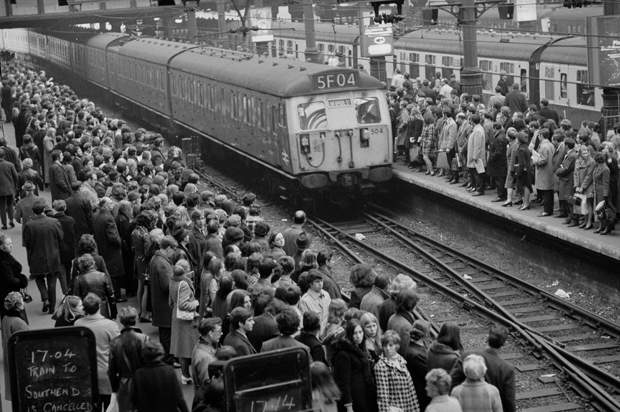In the early days of Victorian railways, train journeys were (rightly) considered so dangerous that ticket offices sold life insurance as well as tickets. There were no onboard toilets until the 1890s, meaning that passengers either had to cross their legs or buy a ‘secret travelling lavatory’, consisting of a rubber tube and bag hidden inside the clothes. Some traditions, though, were already well-established. ‘The real disgrace of England,’ wrote Anthony Trollope in 1869, ‘is the railway sandwich.’
These three facts all come from the first chapter of Iain Gately’s exploration of commuting. They also serve as a neat summary both of what’s best and what’s most odd about Rush Hour as a whole. On the one hand, they’re the sort of fascinating snippets that you may well find yourself wanting to tell friends in the pub. On the other, they don’t actually have much to do with commuting, as opposed to rail travel more generally. While Gately’s title, subtitle and introduction firmly suggest a book about the daily journey to and from work, what we get instead is nothing less than a globe-trotting social history of transport over the past 200 years.
Indeed, the result often feels as if Gately is throwing in anything he’s discovered that he thinks we may find interesting, from the rise of sans-serif typography to life in an Indian call centre (a lot better than you might imagine). At one characteristic point, he remembers ironing his shirts in his own commuting days — before adding a footnote that begins, ‘The desire to smooth and flatten our garments has been present since the days of the Vikings, whose graves contain whalebone “smoothing boards”…’
Luckily, then, he’s almost always right about what’s interesting — his endlessly sharp eye for the memorable historical detail matched by an equally sharp one for the telling statistic (‘China… didn’t get its millionth car until 1992, a figure America reached in 1912’). He’s also adept at the David Kynaston method of using popular culture to illuminate his arguments — noting, for example, that during the golden age of the American suburb, the cartoon shows The Flintstones and The Jetsons celebrated the apparent permanence of suburban life (complete with nuclear households and male breadwinners) by showing it at work in prehistory and the space-age future respectively.
At the same time, Gately never loses sight of the broader sweeps of history — or of historical fashion. Our increasingly shared sense of environmentalism has seen a huge recent revival in bikes as a means of transport. But just over a century ago, it was cars that were seen as the environmental saviours, by getting rid of all that horse manure. As Scientific American put it in 1899, ‘The improvement in city conditions by the general adoption of the motorcar can hardly be overestimated.’
And, as it turns out, whenever Gately does remember that he’s supposed to be writing about commuting, he’s pretty good on that too. In one section, he asks why on earth we put up with the daily commute — and decides that the reason is we secretly rather like it. Not only does the separation of work and home life suit us well, but the journey itself is a chance to think, read and even — according to one survey carried out with electrodes to detect brain activity — experience the same levels of excitement when we’re jostling for space as fighter pilots do during combat. In any case, he argues, human beings (and especially men) are genetically conditioned by their hunter-gathering past to want to travel every day.
Gately’s belief that ‘we must first exterminate this urge from our gene pool before we can dream of a commuter-free planet’ also informs the final section, which speculates about what might happen next — again in transport as much as in commuting. The big IT companies, he points out, may have done more than most to make working from home (aka ‘telecommuting’) possible. Yet, when it comes to their own employees, they take a surprisingly draconian view of anybody who doesn’t turn up in the office. In 2013, Google’s chief financial officer explained that his standard answer to the question, ‘How many people telecommute at Google?’ is ‘As few as possible.’
Admittedly, the strange decision to give Rush Hour a misleading cover story does create some elements of confusion. Quite often, Gately uses the word ‘commuter’ when he really means just ‘passenger’ or ‘driver’. More importantly, he also tends to muddle cause and effect. One of the themes he reiterates regularly is that commuting led to a new way of life in the suburbs — even though, as the rest of the book makes clear, both commuting and the suburbs were themselves caused by developments in public and private transport. Nonetheless, as books sold under false pretences go, this one is hard to beat.






Comments